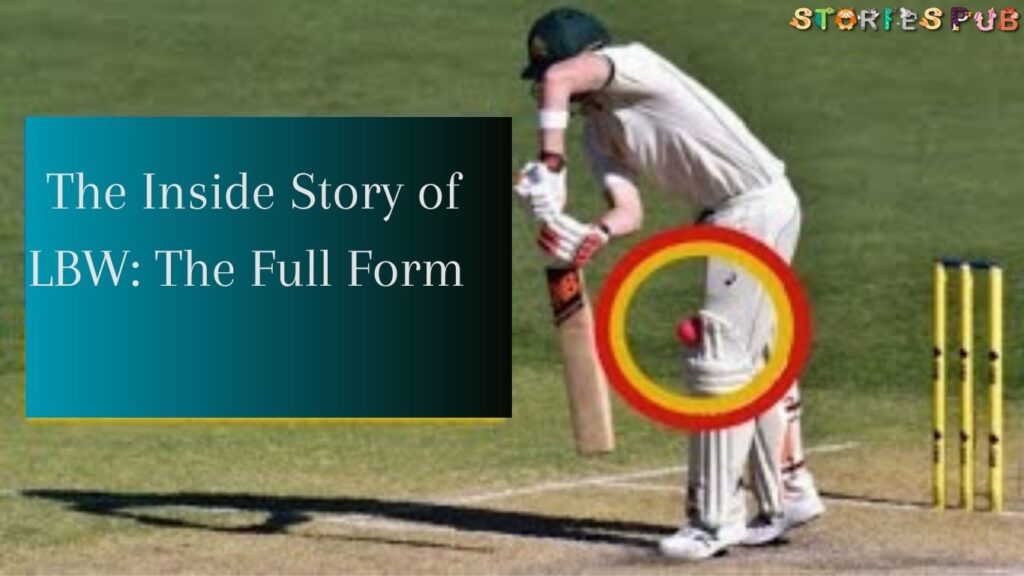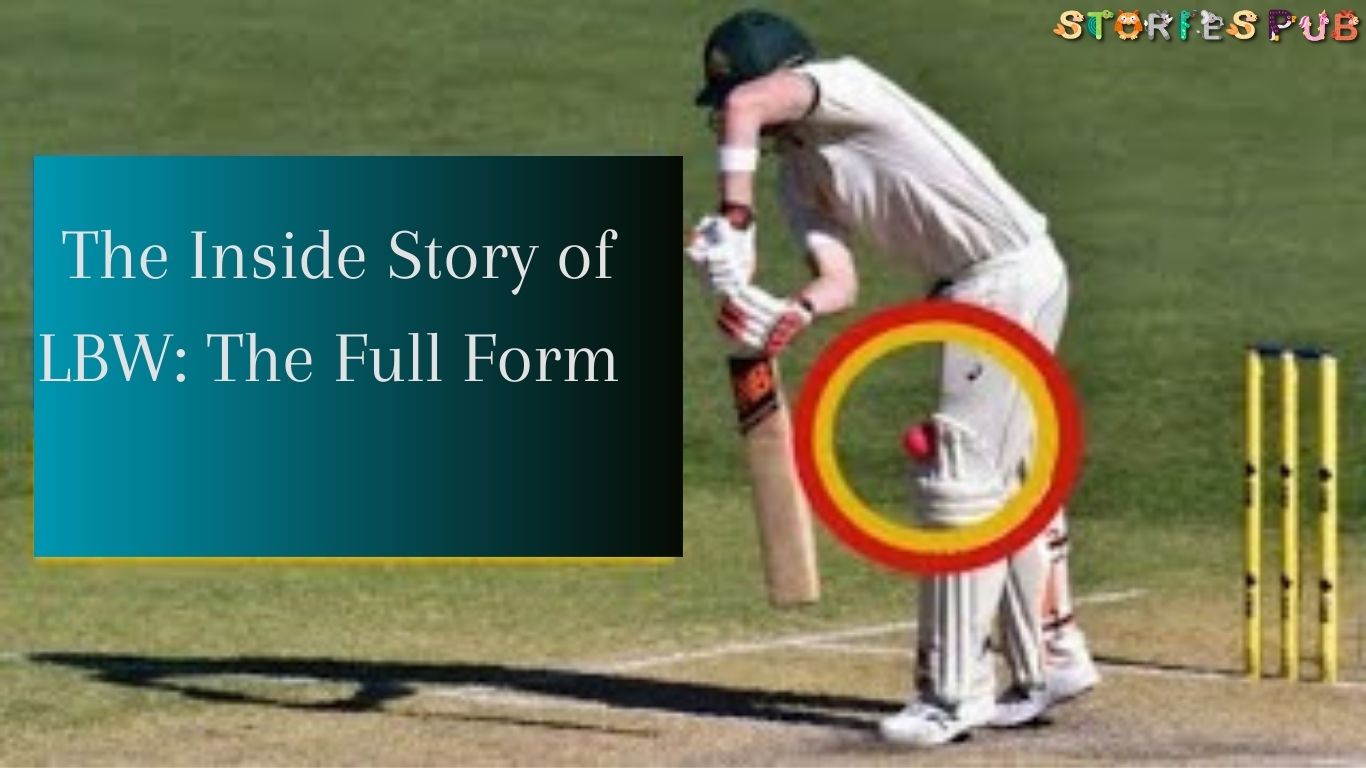The Inside Story of LBW: The Full Form Revealed

The LBW rule, which stands for “Leg before Wicket,” is one of the most important components of cricket, which is frequently considered to as a gentleman’s game.
It’s a rule that has long been a part of cricket’s history and is still up for discussion and controversy among players, spectators, and industry professionals.
To fully grasp the nuances of this regulation, one must be familiar with the complete meaning of “LBW” and its role in the game.
The meaning of LBW, its significance in the game, and how it affects the interactions between bowlers and batsmen on the cricket pitch will all be covered in-depth in this article.
Historical Origins of LBW
Cricket’s early years can be used to trace the development of the phrase “LBW.” As early as the 18th century, there are references to “leg before wicket” in cricket literature and records.
To stop batters from unfairly gaining an advantage by blocking the ball from striking the wicket with their legs, the notion of LBW was devised.
The significance of LBW in the game is highlighted by early references to it in cricket literature and archives. Leg before wicket was added as a method of dismissal when the rules of cricket were originally defined in 1774. Unfortunately, there was no common interpretation of LBW, and it took years of improvements to create a clear grasp of the norm.
Over time, LBW emerged as a key component of cricket’s laws and regulations. The idea of the “point of pitching” was adopted in the 19th century, and it made it clear that the ball had to pitch in line with the wicket for an LBW plea to be accepted.
The “height” and “line” rules, which defined the circumstances under which a batter can be given out LBW, were among the further improvements established in the 20th century.
The requirement for fair play and maintaining the equilibrium between the bat and the ball has influenced the establishment of LBW as a fundamental cricket rule. It has changed over time to take into account shifting playing environments, technological improvements, and the demand for more precise decision-making.
LBW is still an important part of cricket today, influencing both bowlers’ and batsmen’s strategies and frequently determining the result of games.
What is the Full Form of “LBW”
Cricket’s “Leg before Wicket” (LBW) rule, sometimes known as “Leg Before Wicket,” has a big impact on how a game turns out. It describes a scenario in which a batsman gets dismissed because his leg blocks a ball that would have otherwise hit the wicket.
The term “Leg before Wicket,” which encapsulates the heart of the rule, is abbreviated as “LBW” in its expanded form.
Strategies for Bowlers and Batsmen in Dealing with LBW Scenarios
LBW (Leg Before Wicket) is a significant mode of dismissal in cricket, and both bowlers and batsmen need to employ effective strategies to deal with LBW scenarios. For bowlers, tactics such as bowling full and straight, angling the ball, and varying pace or spin can increase the chances of inducing an LBW dismissal.
Batsmen can defend against LBW appeals by maintaining proper footwork, choosing the right shots, and effectively using the Decision Review System (DRS) to challenge incorrect decisions.
Situational awareness and game situation analysis also play a crucial role, with factors such as pitch conditions, the opposition’s bowling attack, and match situation influencing strategies.
By implementing these strategies, players can minimize the risk of LBW dismissals and enhance their chances of success in modern cricket.
Role of Umpires in LBW Decisions
In cricket matches, umpires are incredibly important in deciding LBW (Leg Before Wicket) claims. Making LBW decisions from the umpire’s perspective necessitates a thorough knowledge of the laws, rules, and regulations governing the game.
When deciding whether a ball is LBW, umpires carefully take into account a number of variables, including the line of the ball, the point of impact, and the expected route of the ball.
The umpire must also consider the batsman’s feet, including their location and movement, as well as whether or not the ball would have struck the stumps without the batsman’s legs.
Yet, making LBW decisions as an umpire can be difficult because they must be made at the moment, frequently with poor visibility and under pressure from the players and the game’s circumstances. Umpires must maintain impartiality and accuracy in their judgments while taking many factors into account.
Umpires now have an additional layer of responsibility as a result of technical improvements like the Decision Review System (DRS), as they must interpret and use the technology to help them make accurate LBW rulings.
Also, umpires must deal with contentious LBW rulings that could significantly affect the game’s outcome. Players, coaches, and spectators scrutinize and critique their choices. Notwithstanding these difficulties, umpires are essential in preserving the fairness of the game by impartially deciding LBW appeals and monitoring on-field behavior.
In contemporary cricket, their judgment and decision-making abilities have a big impact on how LBW rulings turn out.
Conclusion
the understanding of the Full Form of “LBW” (Leg Before Wicket) and its historical origins reveal its significance in modern cricket. LBW decisions have a significant impact on matches, players’ performances, and strategic planning for both bowling and batting teams.
Bowlers and batsmen need to employ specific tactics and techniques to induce or defend against LBW dismissals, taking into consideration situational awareness and game situations.
FAQs
What does LBW stand for in cricket?
LBW stands for “Leg Before Wicket.”
How does LBW work in cricket?
In cricket, the term “LBW” refers to a method of dismissing a batsman when the ball strikes the batsman’s leg before hitting the bat and the umpire determines that the ball would have reached the wicket if the leg hadn’t been in the way.
What aspects do umpires weigh when deciding if a player is LBW?
When deciding whether to rule a batsman out for LBW, umpires take into account a number of variables, including the position of the ball, the batsman’s position, the line of delivery, the height of the ball, and the batsman’s movement.
Can LBW decisions be reviewed using the DRS (Decision Review System)?
Yes, LBW decisions can be reviewed using the DRS, which allows teams to challenge the on-field umpire’s decision and seek a review by the third umpire using technology, including ball-tracking and other tools.
How can batsmen defend against LBW appeals?
Batsmen can use strategies such as playing with a straight bat, playing the ball early, using their feet to get closer to the pitch of the ball, and being aware of the line and length of the delivery to defend against LBW appeals.
What challenges do umpires face in adjudicating LBW appeals?
Umpires face challenges such as the speed of the game, the complexity of LBW rules, variations in playing conditions, and the pressure of making split-second decisions, which can sometimes be subjective and contentious.
What are some strategies for bowlers to induce LBW dismissals?
Bowlers can use tactics such as bowling on a good length, varying their line and length, using swing or spin, and setting up the batsman with previous deliveries to induce LBW dismissals.
Hey kids, how much did you like The Inside Story of LBW: The Full Form Revealed, Please share your view in the comment box. Also, please share this story with your friends on social media so they can also enjoy it, and for more such Full form, please bookmark storiespub.com.





